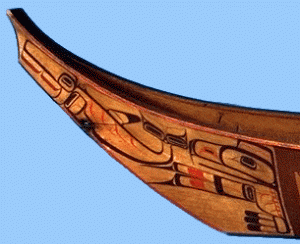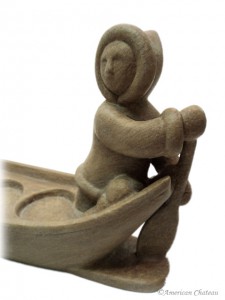Falling Down the Thames Blog 10, 21st May 2014
In A Word
It would be foolish to deny that Krista has more experience in the wild parts of the world than I. However I think it fair to say that I have spent more of my life with my nose in a dictionary. I love dictionaries, and own several including the unabridged Oxford English dictionary in photo-reduced form that requires a magnifying lens to read.
And so, while I leave Krista to tell you about the workings of canoes and kayaks, let me tell you about the origins and usages of those words.
The Gage Dictionary of Canadian English has followed me around since junior high school. It tells me that, as a noun, a canoe is a light boat moved with paddles. The book also provides small pictures of a Kootenay canoe, an Eskimo kayak, a dugout canoe, and a birch bark canoe. The word “Eskimo” has long since been superseded by “Inuit,” at least in Canada, but the dictionary was printed in 1967. The word “canoe” can also be used as a verb, meaning to paddle a canoe, as in “Let’s go for a canoe, and don’t forget the beer.”
I was really disappointed to find that “canoe” is not a Canadian word. Instead, it is apparently New World Spanish, derived from the Haitian word canoa, which was originally an Arawakan word. And because I couldn’t help myself, I looked up the word Arawakan, which is “a family of South American Indian languages, spoken by groups of tribes now found chiefly in northern South America, formerly found in the West Indies and Florida.”
My Australian Concise Oxford dictionary adds that a canoe is keelless. My non-Australian Concise Oxford dictionary adds that a canoe has pointed ends.
But for real linguistic fun, we have to utilize the unabridged Oxford, which says that the word “canoe” has appeared in print since at least 1555, and was originally applied to a watercraft of West Indian aborigines, which were hollowed out of a single tree trunk. The canoe, presumably; not the aborigines.
According to the OED, a “canoe-shell” is a shell shaped like a canoe, and a “canoe-song” is a song sung by a canoeist. A “canoe burial” is exactly what it sounds like. Writing in 1865, E. B. Taylor wrote: “With this belief the canoe-burial of the North West and of Patagonia hangs together.”
My Canadian English dictionary goes on to say that a kayak is “an Eskimo canoe made of skins stretched over a light frame of wood or bone, completely enclosed except for a space left for one person.” Again, it is an old dictionary.
The unabridged Oxford goes crazy with the word “kayak,” explaining that it is of Inuit origin, used by all dialects from Greenland to Alaska. Its earliest recorded use dates to 1662, and a reference to “the single kayaker, who laces the covering tightly around the body to prevent the entry of water.”
But “kayak” has other meanings. It can refer to the alewife, a herring-like fish of the east coast of North America. Writing in 1849, A. Gesner wrote about kayaks in a volume called The Industrial Resources of Nova Scotia, claiming “Sometimes a hundred men, among whom is a sprinkling of Indians, are engaged in taking the ‘kiacks’ from the stream.”
According to a 1963 article in the International Journal of Social Psychiatry, kayak-angst, also known kayak-dizziness and kayak-phobia, is a well-known disorder in all districts of West Greenland.
I trust that in Falling Down the Thames, Krista and I will not suffer kayak-angst, nor be in need of a canoe burial.
- Glen
Photo credits: West Coast dugout canoe, “Northern” style – www.historymuseum.ca; Inuit kayak – upload.wikimedia.org; sculpture of an Inuit kayaker – www.americanchateau.com



